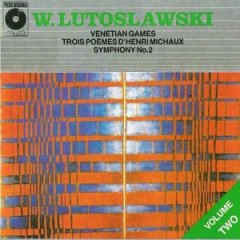Lutoslawski: Venetian Games - Trois Poèmes d´Henri Michaux - Second Symphony (1989)
Lutoslawski: Venetian Games - Trois Poèmes d´Henri Michaux - Second Symphony (1989)

1.Venatian Games Mvt.1 2.Venatian Games Mvt.2 3.Venatian Games Mvt.3 4.Venatian Games Mvt.4 5.Three poems of Henri Michaux – Pensées 6.Three poems of Henri Michaux - Le grand combat 7.Three poems of Henri Michaux - Repos dans le Malheur 8.Symphony no 2 – I. Hésitant 9.Symphony no 2 – II. Direct Camerata Silesia Anna Szostak, conductor Polish Radio National Symphony Orchestra Antoni Wit, conductor
Venetian Games, for chamber orchestra is one of the most important of Lutoslawski's compositions in terms of spreading his reputation worldwide. It was written for performance in Venice in April 1961. Only three movements of the four (the third was as yet unready) were premiered there and the whole piece was first played at the Warsaw Autumn Festival of the same year.
In this piece Lutoslawski expands on an interest in aleatoric music. This term has been coined from the Greek word for "dice" meaning that chance elements are present in the music. As Lutoslawski applied the idea, he frequently leaves to performers some of the choices that are normally dictated by the composer. These are usually in the realm of time, so that strands of music might match up differently from performance to performance. Sometimes the players can choose notes from a limited selection, resulting in the desired harmony but difference in melodic details.
The opening movement is divided into eight sections labeled from A to H. Each begins with a signal from percussion to tell the players when to move from one section to another. Each section corresponds with a box written in the score showing what can be played within the section. The sections contrast with each other like a series of refrains and episode. Instruments are generally restricted to playing certain intervals within gigantic aggregates of two 12-note chords.
The second movement is through-composed, a scherzo in triple meter that simply serves as a transition. In the third movement, the piano plays a twelve-tone row melodically, made of only perfect fourths and perfect fifths, in its prime and altered forms. Meanwhile, the other instruments join in a succession of 16 chords. The final movement is even more aleatoric than the opening one, with overlapping and contrasted instrumental blocks. It is the overlapping and piling on of these blocks that build it to a powerful climax. Once again, 12-note chords dominate the harmony. This is obviously hard and difficult music for most listeners. Even for experienced listeners, these blocks merge into a single sound of dense, shifting textures. ---Joseph Stevenson, Rovi
Lutoslawski has said that the general outline of the work came to him first, and only then did he choose the three poems. These reflect his Francophile taste: Henri Michaux was born in Belgium in 1899 and later became a painter: the trenchant Le Grand Combat, with its onomatopoeic invented words, dates form the 1920s; the other two texts, which are more philosophic than pictorial, form the 1930s. Choir and orchestra need separate conductors even though throughout they alternate more often than they combine.
A description of the course of the music itself will be more useful than any discussion of its technical processes or of its notation. A quiet section of orchestral polyphony, which brass sforzandi punctuate with increasing frequency, frames the beginning and end of Pensées. After the choir’s first unaccompanied passage, the woodwind have a staccato section over which the female voices, singing downward glissandi, are superimposed (‘Ombre de mondes infimes…’). Then the woodwind and both pianos join in a lapping ostinato which illustrates the text of the next forte choir entry ‘Pensées à la nage merveilleuse…’ The climax of the movement comes as these characteristic woodwind figures alternate with the tintinnabulation of a gamelan-like ensemble of vibraphone, céleste, harp and pianos. ---Hugh Wood, musicsalesclassical.com
I composed the SECOND SYMPHONY during 1966 and 1967, some twenty years after my FIRST SYMPHONY. It consists of two movements and although it has nothing in common with the classical or neo-classical symphonies, I decided nonetheless to call it a symphony in the sense that it is written for a symphony orchestra in a large-scale closed form.
The first movement which is subtitled Hesitant comprises a succession of contreasting episodes which are generally fairly lively, punctuated by a recurring slow refrain. This movement merges into a the second which is called Direct and which is in its construction in direct contrast to the first. Although particular phrases or musical episodes can be distinguished here, they are subjugated to the forward motion (direct) which leads to the final conclusion. This contrast seems to me indispensablein a work lasting over half an hour.
The first performance of Direct was given in Hamburg in October 1966 by the Orchestra of the Norddeutscher Rundfunk, conducted by Pierre Boulez. The complete work was given its first performance in June 1967 in Katowice by the Symphony Orchestra of Polish Radio and Television, conducted by myself. ---Witold Lutoslawski, musicsalesclassical.com
download: uploaded filecloudio anonfiles yandex 4shared mediafire solidfiles mega nornar
Zmieniony (Czwartek, 06 Luty 2014 13:13)








